
The kilogram is the base unit of mass in the International System of Units (SI), the current metric system, having the unit symbol kg. It is a widely used measure in science, engineering and commerce worldwide, and is often simply called a kilo in everyday speech.

Measurement is the numerical quantitation of the attributes of an object or event, which can be used to compare with other objects or events. The scope and application of measurement are dependent on the context and discipline. In natural sciences and engineering, measurements do not apply to nominal properties of objects or events, which is consistent with the guidelines of the International vocabulary of metrology published by the International Bureau of Weights and Measures. However, in other fields such as statistics as well as the social and behavioural sciences, measurements can have multiple levels, which would include nominal, ordinal, interval and ratio scales.
A physical quantity is a property of a material or system that can be quantified by measurement. A physical quantity can be expressed as the combination of a numerical value and a unit. For example, the physical quantity mass can be quantified as n kg, where n is the numerical value and kg is the unit. A physical quantity possesses at least two characteristics in common, one is numerical magnitude and other is the unit in which it is measured.

The International System of Units is the modern form of the metric system. It is the only system of measurement with an official status in nearly every country in the world. It comprises a coherent system of units of measurement starting with seven base units, which are the second, metre, kilogram, ampere, kelvin, mole, and candela. The system allows for an unlimited number of additional units, called derived units, which can always be represented as products of powers of the base units. Twenty-two derived units have been provided with special names and symbols. The seven base units and the 22 derived units with special names and symbols may be used in combination to express other derived units, which are adopted to facilitate measurement of diverse quantities. The SI system also provides twenty prefixes to the unit names and unit symbols that may be used when specifying power-of-ten multiples and sub-multiples of SI units. The SI is intended to be an evolving system; units and prefixes are created and unit definitions are modified through international agreement as the technology of measurement progresses and the precision of measurements improves.
In science and engineering, the weight of an object is the force acting on the object due to gravity.
The mole (symbol: mol) is the unit of measurement for amount of substance in the International System of Units (SI). It is defined as exactly 6.02214076×1023 particles, which may be atoms, molecules, ions, or electrons.
The neper is a logarithmic unit for ratios of measurements of physical field and power quantities, such as gain and loss of electronic signals. The unit's name is derived from the name of John Napier, the inventor of logarithms. As is the case for the decibel and bel, the neper is a unit defined in the international standard ISO 80000. It is not part of the International System of Units (SI), but is accepted for use alongside the SI.

A metric system is a system of measurement that succeeded the decimalised system based on the metre introduced in France in the 1790s. The historical development of these systems culminated in the definition of the International System of Units (SI), under the oversight of an international standards body.
ISO 31 is a deprecated international standard for the use of physical quantities and units of measurement, and formulas involving them, in scientific and educational documents. It is superseded by ISO/IEC 80000.
Quantity is a property that can exist as a multitude or magnitude, which illustrate discontinuity and continuity. Quantities can be compared in terms of "more", "less", or "equal", or by assigning a numerical value in terms of a unit of measurement. Mass, time, distance, heat, and angular separation are among the familiar examples of quantitative properties.
ISO 31-0 is the introductory part of international standard ISO 31 on quantities and units. It provides guidelines for using physical quantities, quantity and unit symbols, and coherent unit systems, especially the SI. It is intended for use in all fields of science and technology and is augmented by more specialized conventions defined in other parts of the ISO 31 standard. ISO 31-0 was withdrawn on 17 November 2009. It is superseded by ISO 80000-1. Other parts of ISO 31 have also been withdrawn and replaced by parts of ISO 80000.
ISO 80000 or IEC 80000 is an international standard introducing the International System of Quantities (ISQ). It was developed and promulgated jointly by the International Organization for Standardization (ISO) and the International Electrotechnical Commission (IEC).
The International System of Quantities (ISQ) is a set of quantities and the equations that relate them describing physics and nature, as used in modern science, officialized by the International Organization for Standardization (ISO) by year 2009. This system underlies the International System of Units (SI), being more general: it does not specify the unit of measure chosen for each quantity. The name is used by the General Conference on Weights and Measures (CGPM) and standards bodies such as the International Organization for Standardization (ISO) and the International Electrotechnical Commission (IEC) to refer to this system, in particular with reference to a system that is consistent with the SI. The ISO standard describing the ISQ by 2009 is ISO/IEC 80000, which replaces the preceding standards ISO 31 and ISO 1000 published in 1992.

A unit of measurement is a definite magnitude of a quantity, defined and adopted by convention or by law, that is used as a standard for measurement of the same kind of quantity. Any other quantity of that kind can be expressed as a multiple of the unit of measurement. For example, a length is a physical quantity. The metre is a unit of length that represents a definite predetermined length. When we say 10 metres, we actually mean 10 times the definite predetermined length called "metre". Measurement is a process of determining how large or small a physical quantity is as compared to a basic reference quantity of the same kind.
Quantity calculus is the formal method for describing the mathematical relations between abstract physical quantities. Its roots can be traced to Fourier's concept of dimensional analysis (1822). The basic axiom of quantity calculus is Maxwell's description of a physical quantity as the product of a "numerical value" and a "reference quantity". De Boer summarized the multiplication, division, addition, association and commutation rules of quantity calculus and proposed that a full axiomatization has yet to be completed.

In 2019, the SI base units were redefined in agreement with the International System of Quantities, effective on the 144th anniversary of the Metre Convention, 20 May 2019. In the redefinition, four of the seven SI base units – the kilogram, ampere, kelvin, and mole – were redefined by setting exact numerical values for the Planck constant, the elementary electric charge, the Boltzmann constant, and the Avogadro constant, respectively. The second, metre, and candela were already defined by physical constants and were not subject to correction to their definitions. The new definitions aimed to improve the SI without changing the value of any units, ensuring continuity with existing measurements. In November 2018, the 26th General Conference on Weights and Measures (CGPM) unanimously approved these changes, which the International Committee for Weights and Measures (CIPM) had proposed earlier that year after determining that previously agreed conditions for the change had been met. These conditions were satisfied by a series of experiments that measured the constants to high accuracy relative to the old SI definitions, and were the culmination of decades of research.

The history of the metric system began during the Age of Enlightenment with measures of length and weight derived from nature, along with their decimal multiples and fractions. The system became the standard of France and Europe within half a century. Other dimensions with unity ratios were added, and the system went on to be adopted across the world.

The following outline is provided as an overview of and topical guide to the metric system – various loosely related systems of measurement that trace their origin to the decimal system of measurement introduced in France during the French Revolution.

A coherent system of units is a system of units, used to measure physical quantities, which are defined in such a way that the equations relating the numerical values expressed in the units of the system have exactly the same form, including numerical factors, as the corresponding equations directly relating the quantities. Equivalently, it is a system in which every quantity has a unique unit, or one that does not use conversion factors.
A power quantity is a power or a quantity directly proportional to power, e.g., energy density, acoustic intensity, and luminous intensity. Energy quantities may also be labelled as power quantities in this context.







